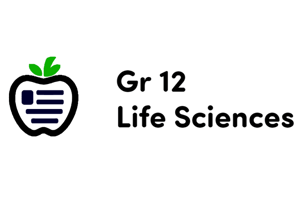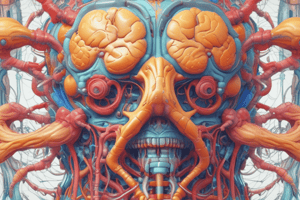Podcast
Questions and Answers
What is the primary focus of physiology?
What is the primary focus of physiology?
- Study of the normal functioning of a living organism and its parts (correct)
- Study of cells and tissues in isolation
- Study of biological evolution and adaptation
- Study of disease and abnormal conditions
Which of the following lists the correct levels of organization in the body?
Which of the following lists the correct levels of organization in the body?
- Molecules → Atoms → Organisms → Cells
- Organic Systems → Organs → Tissues → Cells
- Cells → Molecules → Atoms → Tissues
- Atoms → Molecules → Cells → Tissues → Organs → Organ Systems → Organism (correct)
What does homeostasis maintain in a living organism?
What does homeostasis maintain in a living organism?
- Complete equilibrium with the external environment
- A dynamic steady state of internal stability (correct)
- Permanent separation from external changes
- A fixed, non-changing internal environment
Which feedback mechanism helps maintain homeostasis by reversing changes?
Which feedback mechanism helps maintain homeostasis by reversing changes?
In what scenario can the body be in osmotic equilibrium yet not in electrical equilibrium?
In what scenario can the body be in osmotic equilibrium yet not in electrical equilibrium?
What is a primary characteristic of simple diffusion compared to protein-mediated transport?
What is a primary characteristic of simple diffusion compared to protein-mediated transport?
Which process necessitates the use of energy for transporting substances across membranes?
Which process necessitates the use of energy for transporting substances across membranes?
What is true about the movement through ion channels compared to facilitated diffusion?
What is true about the movement through ion channels compared to facilitated diffusion?
Which of the following statements describes active transport?
Which of the following statements describes active transport?
What describes the function of GLUT transporters in the body?
What describes the function of GLUT transporters in the body?
Flashcards
Physiology
Physiology
The study of the normal functioning of a living organism and its parts.
Levels of Organization
Levels of Organization
The hierarchical structure of living organisms, from simplest to most complex: atoms, molecules, cells, tissues, organs, organ systems, organism.
Homeostasis
Homeostasis
The maintenance of a relatively stable internal environment despite changes in the internal and/or external environment.
Homeostasis Failure
Homeostasis Failure
Signup and view all the flashcards
Negative Feedback
Negative Feedback
Signup and view all the flashcards
Positive Feedback
Positive Feedback
Signup and view all the flashcards
Feedforward Control
Feedforward Control
Signup and view all the flashcards
Osmotic Equilibrium
Osmotic Equilibrium
Signup and view all the flashcards
Electrical & Chemical Disequilibrium
Electrical & Chemical Disequilibrium
Signup and view all the flashcards
Simple Diffusion
Simple Diffusion
Signup and view all the flashcards
Study Notes
Chapter 1: Physiology
- Physiology is the study of the normal functioning of a living organism and its parts.
- Levels of organization range from atoms to molecules, cells, tissues, organs, organ systems, and finally, the organism.
Homeostasis
-
Homeostasis is maintaining a stable internal environment, despite external fluctuations.
-
Homeostasis is a dynamic steady state, not static equilibrium.
-
Sickness or disease occurs when homeostasis is disrupted for an extended time.
-
Negative feedback: Reverses a change to return to a set point.
- Example: Regulating body temperature; when body temperature rises, sweating occurs to cool you down.
-
Positive feedback: Amplifies a change, pushing the system further away from a set point.
- Example: Childbirth, where oxytocin release triggers uterine contractions, which cause more oxytocin release.
-
Feedforward control: Anticipates changes and activates mechanisms to prevent deviations.
- Example: Salivation before eating.
Chapter 5: Osmotic and Electrical Equilibrium
-
Osmotic Equilibrium: The total solute concentration is the same on both sides of the cell membrane, preventing net water movement.
-
Chemical Disequilibrium: Ions and other solutes have unequal concentration across cell membranes.
-
Electrical Disequilibrium: An uneven distribution of ions creates a difference in electrical charge across the cell membrane, creating a resting membrane potential (typically -70 mV). This is maintained by ion channels and pumps.
-
Example of a primary active transport carrier: Sodium-potassium ATPase pump (Na+/K+ ATPase).
- This pump moves 3 sodium ions out of the cell and 2 potassium ions into the cell, using energy from ATP.
Membrane Transport
-
Simple Diffusion: Passive movement of molecules down their concentration gradient. Examples include oxygen and carbon dioxide.
-
Protein-Mediated Transport:
- Facilitated Diffusion: Passive transport with carrier proteins.
- Active Transport: Requires energy to move molecules against their concentration gradient, using carrier proteins or pumps.
- Ion Channels: Passive transport allowing specific ions to pass based on electrochemical gradient.
-
Vesicular Transport: Active transport involving vesicles for moving large molecules or substances, like in exocytosis (releasing molecules) and endocytosis (taking molecules into the cell structures).
Comparing Transport Mechanisms
- Channels: Passive, fast, have selectivity based on size and charge.
- Facilitated Diffusion Carriers: Passive, slower, conformational changes involved.
- Active Transport Carriers: Active, requires energy, usually moves molecules against their concentration gradient.
Carrier-Mediated Transport
- Specificity: Carriers are selective (e.g., glucose transporters).
- Competition: Similar molecules compete for the same carrier.
- Saturation: Maximum transport rate.
Membrane Potential
- Changing ion permeability alters membrane potential.
- Increased Na+ permeability depolarizes the membrane (e.g., during action potential).
- Increased K+ permeability repolarizes the membrane
- Increased Cl- permeability may also depolarize the membrane.
Studying That Suits You
Use AI to generate personalized quizzes and flashcards to suit your learning preferences.




